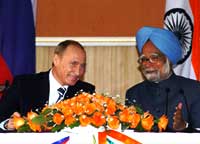26 January, 2007: Putin's day out
By Rajiv Singh | 02 Feb 2007
Thousands throng Rajpath, the wide thoroughfare in the heart of India's capital, New Delhi, on the country's Republic Day every year on 26 January. On display is an impressive parade of the country's military might, besides tableaux that present the country's cultural diversity.
 It is always a stirring moment, marking the passing of another year, and the ushering in of a new one, in the country's developmental march. The parade passes by a podium on which the President, surrounded by foreign dignitaries and senior Indian ministers, takes the salute.
It is always a stirring moment, marking the passing of another year, and the ushering in of a new one, in the country's developmental march. The parade passes by a podium on which the President, surrounded by foreign dignitaries and senior Indian ministers, takes the salute.
The chief guest this year is Russia's president, Vladimir Putin. With a spate of news releases flooding news offices all over the country, mentioning a series of new Indo-Russian defence - and very likely - nuclear deals, Putin's day out on 26 January 2007 may well turn out to be a memorable one.
Fifth generation fighter
The two countries have a long-standing defence arrangement that goes back almost five decades. Currently there are about 200 Indo-Russian defence programmes valued at nearly $18 billion. They extend till the year 2010, when a fresh agreement may be signed. Grandstand deals in recent years include a contract for the modernisation and sale of the Admiral Gorshkov aircraft carrier (renamed INS Vikramaditya), and deals for Sukhoi-30 MKI fighters, the T-90S main battle tank and the supersonic cruise missile BrahMos.
Ratcheting up the cooperation level, Russia and India have now agreed to jointly develop a fifth-generation fighter aircraft, designed by the Sukhoi Bureau. The fighter, according to Russian defence minister Sergei Ivanov, will take to the skies not later than 2009. India and Russia will jointly research and test the aircraft, currently in the third year of development in Russia. Eventually, it will be jointly produced by Hindustan Aeronautics Ltd and Sukhoi.
Glonass
With India's commitment towards the 5th generation fighter made, Russian defence minister Ivanov says India is special. "At present India is the only country with which we want to develop all aspects of Glonass. This demonstrates the general nature of our relations and our willingness to develop cooperation with India in such sensitive areas," he said in Bangalore on 23 January. "The ministry of defence has now removed all limitations on the precision of information received from Glonass."
This is another significant development, with considerable ramifications for India's emergence as a global power. So far Indian forces rely on the US Global Positioning System, with its network of 28 satellites. As warfare steps into the electronic era, and the doctrine of 'network-centric warfare' moving centre-stage, the use of satellite based systems have become an imperative for armed forces.
Some versions of the much touted BrahMos, for example, could turn out to be a lame duck if they are denied access to a satellite-based information and navigation systems. In any clash with US-backed adversaries, India knows that it would be able to access the GPS system only on a 'selective basis', as the GPS allows selective blocking. Though India is also a partner in the European Union's Galileo system, which will be ready in 2008, it is designed only for civilian use. Hence Glonass assumes greater significance.
RD-33 engines and the MRCA contract
All eyes, for now, are on the IAF's 126 multi-role combat aircraft (MRCA) tender, for which the MiG-35 is a hot contender. With the two countries signing an agreement for licensed production of RD-33 engines in India, the balance of favour tilts ever so much in favour of the MiG-35.
The RD-33MK engine will power the MiG-29K/KUB naval versions, designed and built for the Indian Navy. It will eventually power the MiG-35 too, as and when it gets into series production. The Indian Air Force is already in the process of upgrading its operational MiG-29 fighters with RD-29 power plants, which is the initial version of the RD-33MK.
The RD-33MK has by now been overhauled three times, resulting in a two-fold increase in its rated power. This more fuel-efficient power plant, reportedly, cuts operational costs massively compared to the RD-29, and has double the service life. The RD-33MK can now easily power the Indian air force's fleet of MiG-29/Fulcrum and MiG-27/Flogger aircraft, as well as the navy's on-order MiG-29K/KUBs. Eventually it will also power the MiG-35, if it should win the IAF's MRCA order.
BrahMos Russia has clarified that it will not oppose the export of BrahMos supersonic cruise missiles to "specific third countries", in defence minister Sergei Ivanov's words, setting at rest an unseemly controversy that had erupted recently.
Russia has clarified that it will not oppose the export of BrahMos supersonic cruise missiles to "specific third countries", in defence minister Sergei Ivanov's words, setting at rest an unseemly controversy that had erupted recently.
Officials of Rosoboronexport, now Russia's sole agency synchronising its arms export, had accused Indian officials of trashing other Russian missiles sold abroad, in an attempt to boost the prospects of the BrahMos. Reports would suggest that countries such as Malaysia, Chile, South Africa and Kuwait have evinced interest in the BrahMos.
Shivthanu Pillai, CEO, BrahMos Aerospace, the Indo-Russian joint venture company that produces the missile, claims that there is a world market for some 10,000 supersonic missiles, of which the BrahMos class alone would account for some 2,000. He expects the BrahMos to corner a market share of about 1,000 in a couple of years. According to Pillai, global inventories hold some 80,000 subsonic missiles, most of which were "outdated".
The land and naval versions of the BrahMos have already been developed, while work is progressing on the air- and submarine-launched versions. According to Pillai, the air-launched version should undergo tests in 2008. Given the leverage that countries exercise through their supply of strategic weapons, the value of the BrahMos as an asset should be fairly evident.
Titanium
Russian defence minister Sergei Ivanov has also announced that India and Russia will sign an agreement on creating a joint venture for producing titanium dioxide and titanium products. The output would be collected by Russia to partially offset India's "rupee debt" to Russia. Reportedly over 10 per cent of the debt will be written off through the joint venture, which will produce 40,000 tonnes of titanium dioxide every year. Of this amount, 30,000 tonnes will be supplied to Russia.
According to available statistics, this amount should be enough to cover half of Russia's overall need for titanium dioxide, as it consumes about 55,000 tonnes of the material every year.
The erstwhile Soviet Union had pioneered the use of titanium in military and submarine applications in the 1950s and '60s. Titanium is used to create strong, lightweight parts, ranging from armour plating to components for the aerospace, transportation and chemical processing industries. The Su-30MKI's airframe, for instance, is made of titanium and high-strength aluminium alloys.
A legacy
A traditional relationship between the two countries, that has managed to survive geopolitical fallouts resulting from the end of the Cold War, needs to be given a fresh lease of life. Putin, and India, appreciate that the task before them is to put their country's relationship with each other on a more strategic footing, and rescue it from the banalities of the 'client-customer' relationship that have characterised it for quite some time now.
By the looks of it, they may well be on their way towards realising their objective.













.jpg)






.jpg)









